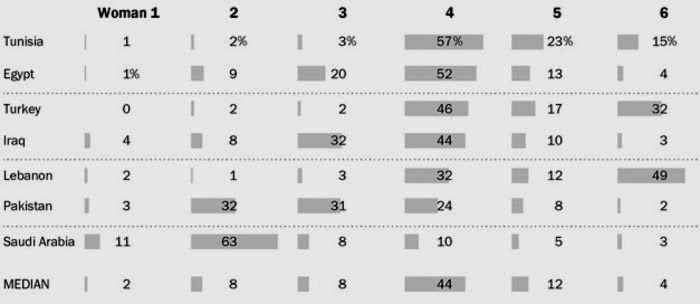Ten Percent of Muslims Call for Niqabs or Burqas
by http://www.nationalreview.com/
January 11, 2014
Cross-posted from National Review Online, The Corner
January 11, 2014
Cross-posted from National Review Online, The Corner
A survey conducted in seven Muslim-majority countries (Tunisia, Egypt, Lebanon, Turkey, Saudi Arabia, Iraq, and Pakistan) finds that a median of 10 percent of the respondents prefer women to wear either a niqab or burqa when in public. The specific country figures range enormously, from 74 percent approval of these two garments in Saudi Arabia and 35 percent in Pakistan to 3 percent in Lebanon and Tunisia and just 2 percent in Turkey.

Woman #4, whose hair and ears are covered by an amira, was far and away, deemed the most appropriately dressed for appearing in public, with 44 percent of the vote, followed in a distant second place by the lighter hijab of woman #5 at 12 percent. No head covering at all found a measly 4 percent support.
Technical details: Respondents were shown six pictures of women in different styles of head dress and asked "Which one of these women is dressed most appropriately for public places?" The data derives from pp. 54-55 of "The Birthplace of the Arab Spring: Values and Perceptions of the Tunisian Public in a Comparative Perspective," a study conducted by the University of Michigan's Institute for Social Research and published on December 15, 2013. Jacob Poushter of the Pew Global Attitudes Project visually recast the figures in the form shown here. The sample sizes per country range between 2,000 and 3,500. The surveys were conducted between January 2011 and June 2013.
Comments:

Semi-naked niqabi protesters in Paris in 2010 got the attention they sought.
|
(2) Using a median rather than an average makes no difference in the case of the combined support for niqabs and burqas; were averages used, that would also be 10 percent. In the case of uncovered women, however, it would make a substantial difference, bringing support up from 4 percent to 15.5, or nearly four times as much.
(3) The Michigan study concludes from these findings that
I concur, except that Saudi Arabia cannot be considered modern, only rich. To put it simply, what counts when it comes to women's attire in public is values, not wealth. Phrased differently, Westernization is an inextrictable part of modernization, whether that means democracy, Beethoven, or unveiled women. (January 11, 2014)it would be hard to connect women's style of dress on the aggregate level to a country's level of development and modernity. Saudi Arabia, which is economically more developed, is most conservative in terms of women's style of dress. Rather, it reflects a country's orientations toward liberal values as well as the level of freedom people enjoy. In Lebanon, Tunisia, and Turkey, where people tend to be less conservative than the other four countries, the preferable style for women also tend to be much less conservative than the other four countries.
-----
If you found this post interesting or informative, please  it below. Thanks!
it below. Thanks!
 it below. Thanks!
it below. Thanks! 

No comments:
Post a Comment